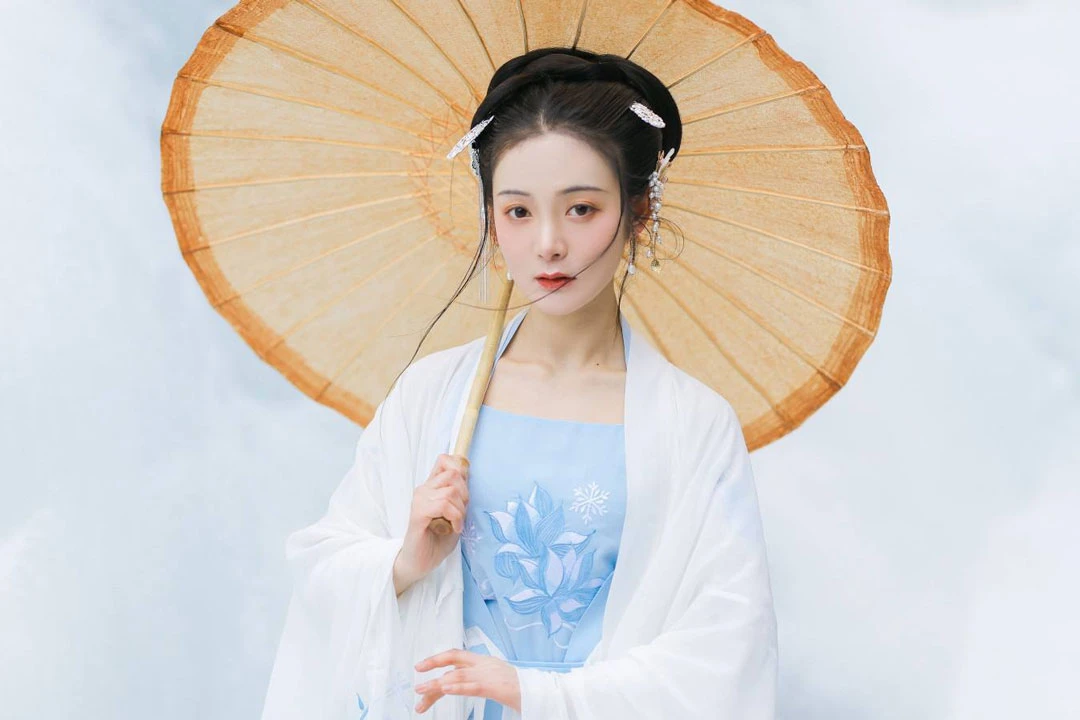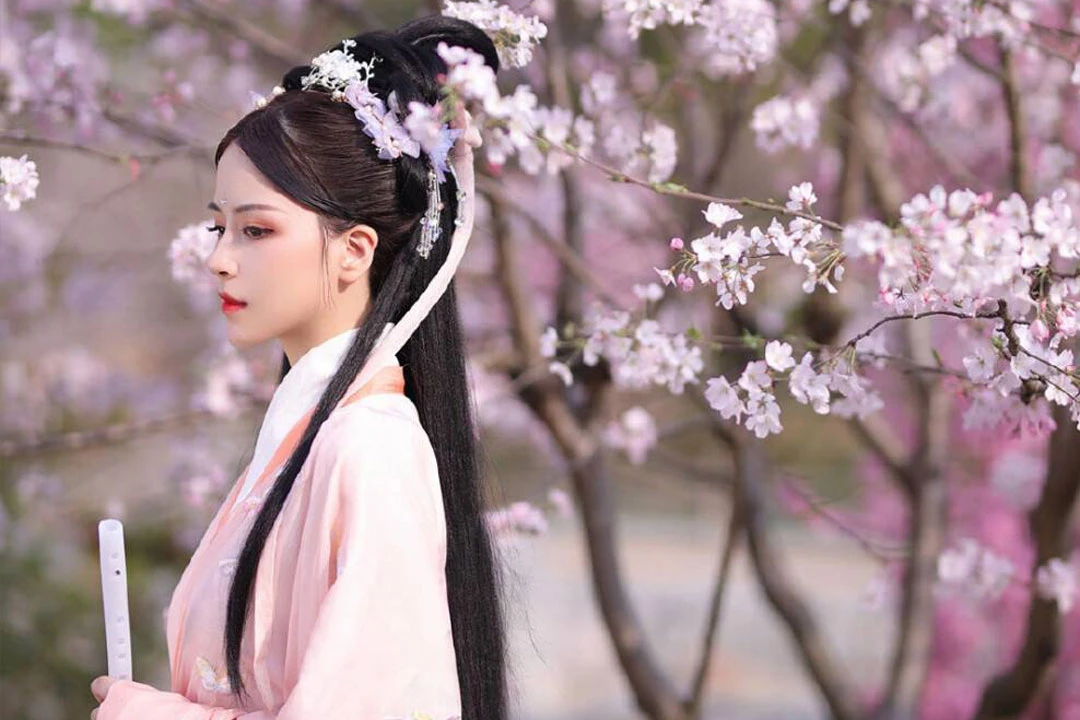White, the canvas on which history paints its tales, symbolizes purity, simplicity, and a timeless elegance within Hanfu. However, navigating the intricacies of wearing white, especially in Hanfu, demands an understanding of its nuances.
The inherent tendency of white to accentuate darker tones, even the slightest hint of yellow or tan, poses a challenge. Additionally, the susceptibility of white to stains demands a certain level of mindfulness. Yet, these challenges underscore the versatile nature of white, offering an opportunity to transform it into an enhancer of beauty rather than a detractor.
In the realm of Hanfu, the choice of style is paramount. A meticulous selection of styles that evoke youthfulness, elegance, and classical charm can transform the narrative of white. The Ming-style cloud shoulder Hanfu, with its delicate cloud shoulder design, emerges as an exquisite choice. Alternatively, the incorporation of white into sheer fabrics for overlays not only imparts freshness but also mitigates concerns about appearing lackluster.
For those whose skin tones don’t seamlessly align with pure white, the subtlety of off-white or cream shades offers an elegant alternative. These hues possess an inherent grace and forgiveness, making them a perennial favorite within the spectrum of white. The off-white palette exudes sophistication and is undoubtedly worth exploring for Hanfu enthusiasts.
White Hanfu Across Dynasties
White Hanfu holds a revered place in the historical tapestry of Chinese fashion. Its significance transcends mere aesthetics, weaving through dynasties, each era adding a layer to its cultural narrative. From the Ming and Qing dynasties to the more recent dynastic transitions, white Hanfu has been donned in various styles, each reflecting the ethos of its time.
During the Ming Dynasty, white Hanfu symbolized elegance amidst political turbulence. Intricately designed cloud shoulders and delicate embroidery adorned the attire, signifying a resilient spirit during challenging times. The Ming era’s white Hanfu encapsulates a narrative of grace in the face of adversity.
The Qing Dynasty witnessed a fusion of Han and Manchu influences in fashion. White Hanfu, adorned with cloud patterns and elegant embroidery, became a canvas for cultural amalgamation. The exquisite detailing in Qing-era white Hanfu underscored the synthesis of diverse influences, creating a unique sartorial identity.
While rooted in tradition, Hanfu has experienced a renaissance in contemporary fashion, breathing new life into classic styles. The resurgence of white Hanfu in modern times reflects a yearning for the timeless elegance of the past while embracing the fluidity of the present.
Contemporary designers have seamlessly blended traditional elements with modern aesthetics, creating white Hanfu pieces that resonate with a global audience. The use of innovative fabrics, streamlined silhouettes, and creative embellishments has propelled white Hanfu into the realm of high fashion, appealing to both traditionalists and modern enthusiasts.
Accessories and Embellishments
Accessories and embellishments serve as the finishing touches that elevate white Hanfu to new heights of elegance. From delicate hairpins to ornate headdresses, the choice of accessories can accentuate the grace and charm of white Hanfu.
Incorporating floral motifs in accessories brings a touch of nature to white Hanfu, adding vibrancy and symbolism to the ensemble. Floral hairpins, embroidered sashes, and intricate floral patterns on white fabric create a harmonious blend of tradition and natural beauty.
Each embellishment on white Hanfu tells a story, whether through traditional symbols, auspicious motifs, or intricate embroidery. The artistry embedded in these embellishments connects the wearer to the rich cultural heritage of China, transforming white Hanfu into a wearable masterpiece.
Navigating Complexion Concerns with White Hanfu
Confidence in wearing white Hanfu extends beyond the choice of style and accessories; it encompasses an understanding of how to complement one’s complexion.
While white may accentuate darker tones, strategic contrasts can harmonize the overall look. Pairing white with complementary colors such as light green, lotus pink, or pale yellow softens the contrast, creating a balanced and refined appearance. This approach not only ensures a visually cohesive ensemble but also celebrates the diversity of skin tones.
Strategically placing white in the ensemble can mitigate concerns about its potential to darken the complexion. Avoiding white for upper garments or areas close to the face minimizes the contrast, allowing white to enhance the overall aesthetic without overshadowing the natural beauty of the wearer.
White Hanfu Bridal Ensembles
The allure of white Hanfu extends to the realm of weddings, where it becomes a symbol of purity, elegance, and the timeless union of two souls.
Brides opting for white Hanfu on their wedding day embody the timeless elegance of centuries past. The choice of white symbolizes purity, and the intricate details of Hanfu add an ethereal quality to the bridal ensemble. The result is a wedding aesthetic that transcends trends, creating memories that echo through the annals of time.
From auspicious motifs embroidered into the fabric to the choice of accessories, each element contributes to a narrative of love, union, and the promise of a shared future. White Hanfu in weddings becomes a poetic expression of a couple’s journey, weaving tradition and symbolism into the fabric of their matrimony.
White Hanfu in the Evolving Landscape
As we stand at the crossroads of tradition and modernity, the future of white Hanfu holds promise in an ever-evolving fashion landscape.
The integration of technology and innovation in design is reshaping the landscape of white Hanfu. From 3D-printed embellishments to smart textiles, designers are pushing boundaries while preserving the essence of tradition. This fusion of ancient aesthetics with modern technology ensures that white Hanfu remains relevant and captivating in the years to come.
In conclusion, the journey through the realm of white Hanfu is a testament to its enduring charm and cultural significance. From its roots in history to its contemporary resurgence, white Hanfu continues to captivate hearts, bridging the past and the future. As we navigate the evolving landscape of fashion, one thing remains certain: the elegance of white Hanfu will continue to weave its enchanting story for generations to come.


